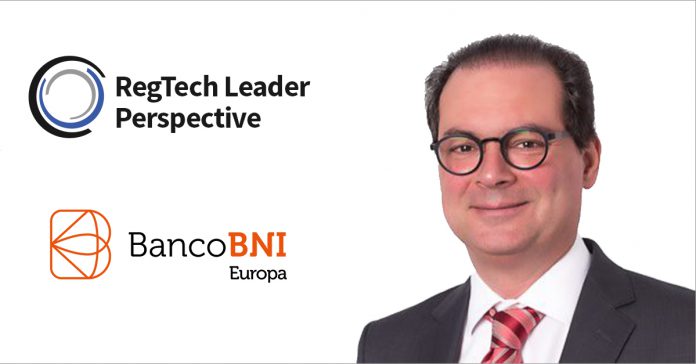A centralised database for suspicious transactions would be the best way to help financial institutions improve the fight against money laundering and fraud, according to Pedro Pinto Coelho, CEO at Banco BNI Europa.
It seems that every week there is another financial institution being hit with a fine for failures in anti-money laundering. Both challenger banks and traditional financial institutions are at the end of an apparent endless string of breaches. The €200m Danske Bank scandal has been one of the most prominent to feature in the news, but JPMorgan and HSBC have also been recent targets to AML-related fines. Just this month, Standard Chartered was hit with a combined fine of over $1bn from a number of US and UK regulators for failings in their AML controls.
With AML having this potential as a hot bed for fines it has obviously not gone unnoticed by financial institutions and millions of dollars in resources has gone to finding fixes and close the stream of fines at its source. Of the $9.9bn to be invested in the RegTech sector since 2014, 28 per cent of this (2.7bn) has been deployed into companies which are building AML solutions, according to RegTech Analyst data. The only RegTech sub-sector to receive more funding has been KYC, which has a 34.5 per cent share of the overall funding.
The biggest challenge which is facing financial institutions regarding their AML processes is just the sheer magnitude of the task. Pedro Pinto Coelho, CEO at Banco BNI Europa said, “it’s virtually impossible to be able to control every single transaction that is going through the system because our organisations are quite large. Unless you actually have a very good AML monitoring system, to be able to actually monitor every single transaction or every alert would be rather impossible if you just had a huge compliance team looking at every single transaction. And that would be too expensive for any bank to implement.”
In order to have a fighting chance of meeting AML compliance, Coelho said that it was a necessity for financial institutions, especially larger ones, to adopt automated tools to handle the monitoring of transactions. These tools with high processing powers will be the only way a bank can guarantee their transactions and relationships with consumers are meeting the required compliance.
However, automated tools only have the power to do so much and only solves AML issues at banks individually, not across the board. If the financial market wants to effectively lower the risks towards money laundering or fraud, there needs to be a centralised database where banks would report all of their suspicious clients or transactions, Coelho said. It would operate in a similar way to the current centralised way for reporting debtors and their positions.
“We would have to move towards a single model for the compliance side as that would help banks not having to do the work twice. If there is someone that has originally done something suspicious in a previous transaction, banks would know upfront that this client is a high-risk client. Therefore, systems would closer monitor these types of transactions coming from this particular set of clients.”
This will only be possible to build if it becomes mandatory for all financial institutions. If only a handful of institutions are sharing their suspicious transaction data, it would not be as effective, and the benefits would only be marginal. This requires encouragement from regulators; however, Coelho believes that first, regulators need to evolve their attitudes towards sensitive information sharing between financial institutions. Currently, each AML study is done by banks independently and this just adds unnecessary burdens and processes.
“We need the regulators to overcome this idea that every single institution has to do its own compliance process, KYC and AML separately, and not trusting the other institution. Let’s say if you send somebody from Lloyds to Barclays, even if you are a client of Barclays, Lloyds has to know who you are, what transaction it is and all that. We have to come to a point where we believe that it’s better to share information between institutions rather than us trying to supervise every other institution. We would assume that this institution is doing this type of duty according to the rules.”
As with everything, there are potential problems or ways for new issues to form in the place of those solved. An instance which could occur would be a bank blaming another’s research and information around a suspicious player for any issues that arise. It also could spawn challenges of inaccuracies, if the bank conducting the AML investigation on a consumer is wrong and this is then transmitted to the central database, all other banks accessing it would be using the same inaccurate analysis.
These are challenges which would need to be addressed and regulators would need to put in safeguards to ensure this does not happen. Overall benefits from a centralised suspicious transaction database would far outweigh these challenges. Regulators would also be able to take advantage of the system, improving their understandings of current issues and the level of criminality in the market, and helping their efforts to oversee it all.
The fact of the matter is, a centralised database would not even be a particularly complex system to setup. Banks are already required to report information around suspicious transactions. For example, US financial institutions are obliged by the Financial Crimes Enforcement Network to complete suspicious activity reports and this is a similar system to a number of other countries and their regulators. This information is just being held by regulators, and simply sharing this with other financial institutions can help combat tax evasion and fight fraud.
RegTech solutions would only make this even more effective. By assessing all of the transactions being conducted through the bank and then assessing information on the centralised database to decide whether transactions are suspicious or fraudulent. AI and machine learning have become buzzwords across the industry, but it’s for good reasons. These types of technology would be able to learn a lot quicker than compliance teams and substantially reduce the number of false positives, he said. Even without the centralised databases, RegTechs offer the ability to save masses of time.
“RegTech’s are the only solution because otherwise we would have to increase the compliance teams for magnitude which would be a huge burden for banks. Compliance teams are growing the fastest and there are still not as effective as they should be, and they are doing manual work that can be done by a machine. That’s why it’s critical to implement a machine which is far cheaper and more effective than a group of compliance officers. Rules are changing every day, even regulations are changing, so we need to have platforms that actually store this information on a permanent basis.”
BNI Europa is no stranger to teaming up with RegTech solutions. Earlier this year, the bank formed a deal with API developer NDGIT to improve its open banking capabilities. On March 14, PSD2 entered the final phase before its September deadline, and financial institutions had to ensure a test environment was ready to test APIs. BNI Europa formed the deal to ensure it was ready for these requirements.
To hear more from Pedro Pinto Coelho, he will be speaking at the Global RegTech Summit on 15th May in London. He will be speaking on a panel with other RegTech leaders to discuss corporate investments and partnerships with startups and scaleups.
Copyright © 2018 RegTech Analyst






